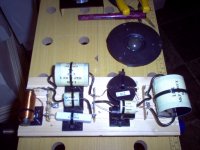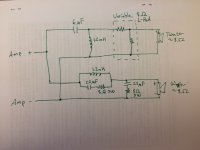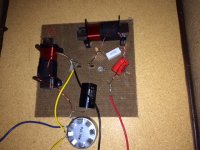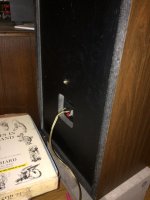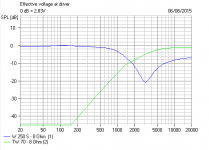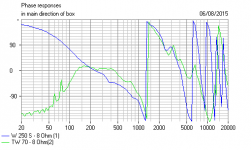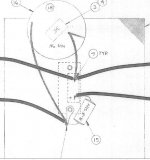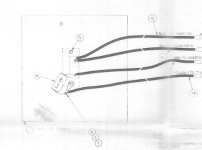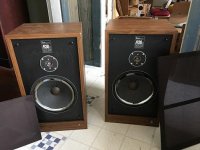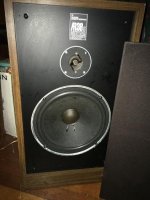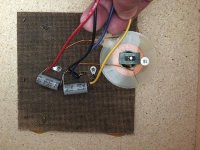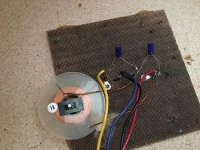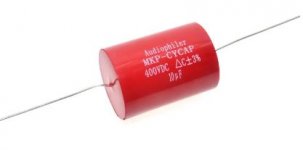Steve, you were really right about the importance of that 3k notch filter! I reconfigured the Bessel filter on my woofers by removing the shorting cap and putting 2.2uF + 8R in parallel with the 1.2mH I already had. They were a bit bright in my room, but that was easily corrected with the variable L-Pad.
The midrange glare all disappeared and now the AR38s is quite pleasant to listen to! Fairly smooth response from the bottom to the top. Good live recordings sound realistic, comparing favorably to the Grado SR125i + hybrid amp system on my desk at work. I'm pleased.
Thanks, Steve, for your advice! I can highly recommend this simple mod to anybody that picks up a derelict pair of AR-38s speakers. They make music!
The midrange glare all disappeared and now the AR38s is quite pleasant to listen to! Fairly smooth response from the bottom to the top. Good live recordings sound realistic, comparing favorably to the Grado SR125i + hybrid amp system on my desk at work. I'm pleased.
Thanks, Steve, for your advice! I can highly recommend this simple mod to anybody that picks up a derelict pair of AR-38s speakers. They make music!
I don't know quite what you did there, mress, but I admire your enthusiasm. Did you fit a shunt RC component to the bass filter too? 
I fiddle around with crossovers and Visaton Boxsim a lot. The fact is some drivers play nicely together, and others don't.
The tank is a good circuit to align phase sometimes. I'm using one below. And phase alignment matters. Though, TBH, I don't think many people get it with phase. Good phase alignment makes the speaker sound integrated and tells you a lot about resonances. Interestingly, Troels Gravesen always says it's best to just tackle the very worst bumps, which kinda stand out and make themselves known.
You can forgive minor faults.
I fiddle around with crossovers and Visaton Boxsim a lot. The fact is some drivers play nicely together, and others don't.
The tank is a good circuit to align phase sometimes. I'm using one below. And phase alignment matters. Though, TBH, I don't think many people get it with phase. Good phase alignment makes the speaker sound integrated and tells you a lot about resonances. Interestingly, Troels Gravesen always says it's best to just tackle the very worst bumps, which kinda stand out and make themselves known.
You can forgive minor faults.
Attachments
Just for future reference... here's pics and a schematic of my AR-38s speakers after modification. The little screw on the back of the speaker is for adjusting the tweeter level.
The Zobel is soldered directly across the woofer terminals. Not the best for reliability, but I was running out of space on the back of the cabinet.
The schematic is the same as System7 posted. The component values are a little different based upon what I had available. Doesn't seem to be a big deal.
With this mod it's a pretty OK speaker that makes me happy when I listen to it.
The Zobel is soldered directly across the woofer terminals. Not the best for reliability, but I was running out of space on the back of the cabinet.
The schematic is the same as System7 posted. The component values are a little different based upon what I had available. Doesn't seem to be a big deal.
With this mod it's a pretty OK speaker that makes me happy when I listen to it.
Attachments
Last edited:
Very nice. Should be pretty flat response IMO. 
Good to see a project come to fruition!
I can show you the electrical response of the filter, and the rough phase alignment looks good too. From the the slightly different FR plots of the Visaton TW70 and the flatter AR cone tweeter, I think frequency response is going to have no alarming bumps. 10/10 IMO!
Good to see a project come to fruition!
I can show you the electrical response of the filter, and the rough phase alignment looks good too. From the the slightly different FR plots of the Visaton TW70 and the flatter AR cone tweeter, I think frequency response is going to have no alarming bumps. 10/10 IMO!
Attachments
Sure it was an AR18S? That one had a 8" bass and simple 5uF on the tweeter:
https://www.gearslutz.com/board/reviews/691582-acoustic-research-inc-ar18s.html
Purist simple AR Crossovers below for AR18S and AR28S. Both positive polarity on tweeter. But I think you could do better.
https://www.gearslutz.com/board/reviews/691582-acoustic-research-inc-ar18s.html
Purist simple AR Crossovers below for AR18S and AR28S. Both positive polarity on tweeter. But I think you could do better.
Attachments
Last edited:
hi mress been off for a while, just moved in to new place, thank you for your post, just got them woofers, tweeters and xovers, i researched the box dimension though, i'm planning on having it made in The Philippines during my visit home this coming holidays, timber is cheaper there!!
You'll probably end up with much nicer-looking speakers than stock. If you get them from 3/4" or 1" plywood instead of MDF, they may sound a bit nicer too.
At least they're a sealed box, so there's not much to worry about: just do the measurements, build the box well, and caulk the joints!
Good luck!
At least they're a sealed box, so there's not much to worry about: just do the measurements, build the box well, and caulk the joints!
Good luck!
Good thread this. It's a sort of poor man's DeVore Orangutan or Dynaco A25 or SEAS A26 kit IMO.
Good review which clears up a few points, especially about the ferrofluid tweeter.
It's all in the 3kHz notch on the 10" bass and no reason why you can't improve AR's filter with second order on the cone tweeter. It effectively behaves like first order anyway. So you get good impulse response IMO. It's one of those sweet and easy combinations of drivers. I used to have something like this myself, called the Wharfedale Melton II.
Good review which clears up a few points, especially about the ferrofluid tweeter.
http://www.nytimes.com/1981/04/26/arts/sound-the-best-loudspeaker-for-the-money.htmlNY Times Arts section said:Sound; THE BEST LOUDSPEAKER FOR THE MONEY
By HANS FANTEL
Published: April 26, 1981
When a product is intended to sell at a modest price, it is often necessary to make design compromises to keep the cost down. The intelligence excercised in choosing and balancing those compromises makes the difference between a good cheap product and a product that is merely cheap.
This point is exemplified by a recently introduced low-cost loudspeaker combining affordable price with exceptional sound. Nobody would claim that the new Acoustic Research AR-38s, listing for $150 but usually selling for less, ranks among the best. But it certainly ranks among the best for the money. With evident intelligence and maybe a bit of luck, its designers managed to shave costs at precisely those points that least detract from the subjective experience of the music. The result is a speaker whose sound needs no excuses but whose price remains within reach of budget-bound buyers.
True to its own tradition, Acoustic Research conceived the AR-38s as an acoustic suspension speaker, following the principle pioneered by the company at its inception more than 25 years ago. What distinguishes acoustic suspension speakers is a tightly sealed enclosure to prevent the formation of false resonance in the lower range. Speakers of this kind are noted for their accurate bass. Instruments such as the contrabass or the kettledrum are rendered at the right pitch rather than than disguised as an indistinct thump or thud. This contributes greatly to the clarity of the overall sound texture, allowing orchestral detail to remain discernible even in heavily scored passages where cellos and basses, usually playing in octaves, radiate large amounts of low-frequency energy.
These virtues are gained in speakers of this type at some sacrifice in efficiency. When applied to loudspeakers, the term efficiency indicates how much amplifier power must be fed to the speaker to produce a certain loudness level. To say that a speaker is inefficient does not reflect adversely on its tonal quality. It merely signifies that a fairly large amount of power is needed to drive it to room-filling volume levels. In the case of the AR-38s, a minimum amplifier power of 15 watts (per channel) is suggested. But since nearly all quality receivers nowadays provide at least 20 watts per channel, this requirement entails no practical disadvantage. Trading off efficiency for the sake of accurate bass is typical of the judicious thinking in back of this design.
The range of the bass represents another intelligent compromise. Using a 10-inch woofer in an enclosure of moderate size (24x14x10 inches) this speaker makes no pretense at reaching to the very bottom of the musical gamut, and its rendition of the deepest pedal notes of a great pipe organ lacks ultimate force and conviction. But then again, such notes occur but seldom in most kinds of music, and within the ordinary orchestral range - down to 45 Hz - the speaker's response is gratifyingly well balanced.
The high end of the tonal spectrum is entrusted to a liquid-cooled cone tweeter. The notion of a liquid-cooled loudspeaker may seem a bit quixotic -evoking visions of elaborate plumbing - but luckily it requires no pipes. All it takes is a dollop of special fluid squirted into the tweeter's innards at the factory. The fluid than clings to the moving parts and its thermal conductivity draws off the heat resulting from the tweeter's musical exertions. Especially when playing very loud, tweeters grow so hot that their internal temperature alters their shape, hampers their sound, and might cause lasting damage. The liquid cooling forestalls such danger and allows the speaker to deal with stronger signals than it could handle otherwise. In consequence, the AR-38s remains unfazed by power levels up to 100 watts, which is remarkable for its size and should suffice for raising rafters or rousing neighbors.
In a series of critical listening tests, the AR-38s proved its musical worth in a varied repertory. Orchestral strings melded smoothly into cohesive sonority, yet without any loss of sonic detail. The darker textures of a Brahmsian score demanded slightly heavier bass than the speaker normally provides, but the matter was easily set right with a slight bass boost from the amplifier's tone controls. A soprano came through the speaker with her true vocal timbre and none of the overbright coloration that many poorly designed speakers impart to female voices in the upper register. Each instrument in a jazz combo was articulated with a pleasing sense of aural presence, and particularly the guitar emerged with convincingly plectral zing and pluck.
Only Wagnerian cataclysms hinted perceptibly at limitations in this speaker. But even those orchestral onslaughts left unshaken our opinion that the AR-38s, judged on a cost/performance basis, represents outstanding value.
It's all in the 3kHz notch on the 10" bass and no reason why you can't improve AR's filter with second order on the cone tweeter. It effectively behaves like first order anyway. So you get good impulse response IMO. It's one of those sweet and easy combinations of drivers. I used to have something like this myself, called the Wharfedale Melton II.
Hi there!
I've just bought a nice pair of 38's and would like to recap them.
could you assist me and point on a link where I can buy 6uf 50v caps?
Tried on ebay but unfortunately didn't get accurate results.
I did found something but it was too expensive (6$/piece)
Thanks!
Tal
AR38S - restore and recap
Hi Tal, a year since you posed the question 'where is a good source for 50V 6uf non-polarized capacitors?'. I expect you have got some by now. I restored a pair of AR38S and used aliexpress, I got 6uf 50v Bipolar capacitors in a packet of 30 for $6.33. They are radial instead of the original axial. They sounded fine to me, but the comment I got after posting pictures on another AR speaker forum was that 'Those tiny NPE's probably have very high ESR (some are 2-3 ohms and not intended for crossovers) it might tone down an otherwise hot high end.'
So I am going back to aliexpress and getting their Audiophile quality ones. These are axial like the originals. The closest uf value is 5.6uf, that they are 250v or 400v doesn't matter, so long as they are higher than 50v. These run about $1 US each and postage for 2 is $2.
Here are some photos of the AR38s which I got for $10 at an auction.
Photo before refoaming
Photo after refoaming
Original Crossover
Crossover after install of cheap 50v 6uf NP caps
Audiophile cap of the type i have on order 400v 5.6uf NP
Hi Tal, a year since you posed the question 'where is a good source for 50V 6uf non-polarized capacitors?'. I expect you have got some by now. I restored a pair of AR38S and used aliexpress, I got 6uf 50v Bipolar capacitors in a packet of 30 for $6.33. They are radial instead of the original axial. They sounded fine to me, but the comment I got after posting pictures on another AR speaker forum was that 'Those tiny NPE's probably have very high ESR (some are 2-3 ohms and not intended for crossovers) it might tone down an otherwise hot high end.'
So I am going back to aliexpress and getting their Audiophile quality ones. These are axial like the originals. The closest uf value is 5.6uf, that they are 250v or 400v doesn't matter, so long as they are higher than 50v. These run about $1 US each and postage for 2 is $2.
Here are some photos of the AR38s which I got for $10 at an auction.
Photo before refoaming
Photo after refoaming
Original Crossover
Crossover after install of cheap 50v 6uf NP caps
Audiophile cap of the type i have on order 400v 5.6uf NP
Attachments
- Status
- This old topic is closed. If you want to reopen this topic, contact a moderator using the "Report Post" button.
- Home
- Loudspeakers
- Multi-Way
- ar38s speaker cross over capacitor value
